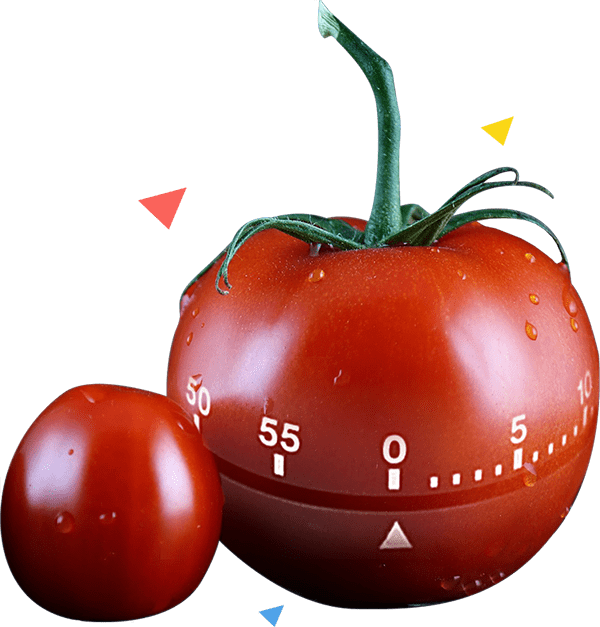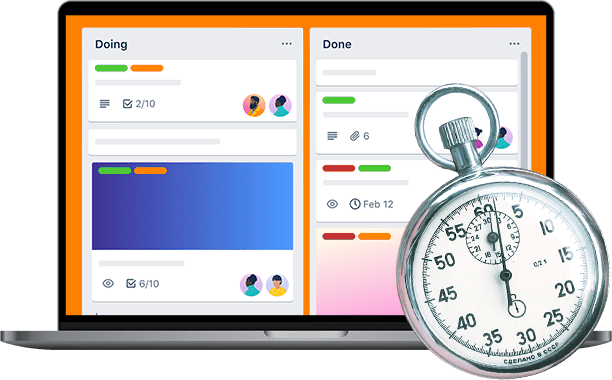
The Pomodoro Technique Ultimate Guide
How much work do you get done on an average work day?
Even though you may be at work for eight hours or so, you probably don’t get eight hours of work done. In fact, you probably get much less done than you realize.
Between meetings and emails and Slack chats and texts and social media, you probably don’t make a huge amount of meaningful progress on your most important work.
You can change that though.
How?
The Pomodoro Technique (some call it the Pomodoro Method).
In this guide, we’re going to show you how this one, simple strategy can dramatically increase your productivity.
Ready? Let’s get started.
What Is The Pomodoro Technique?
The Pomodoro Technique is a popular time management method that helps you work in relatively short, focused bursts, followed by periods of rest. It was pioneered by Francesco Cirillo, and he named it after a timer he used that was shaped like a tomato (“pomodoro” is the Italian word for “tomato”).
The principles underlying the Pomodoro Technique are simple: do intensely focused work for a short period of time, and then give your brain a short period of rest. By consistently doing this, you are able to shut out distractions and get more done in less time. You’re also able to maintain your mental stamina since you’re taking intentional breaks.
The Pomodoro Technique is ideal if you:
Honestly, this technique works really well for just about anyone who wants to be more productive. Though very simple, it’s also very effective. It can be adapted to just about any sort of work, which is one of the main reasons it works so well.
How Does The Pomodoro Technique Work?
In practice, the Pomodoro Technique is extremely simple. It works like this:
Very simple, very effective.
Now, a few things to note to get the most out of the Pomodoro technique.
Break down big tasks into smaller ones
If a particular task is going to require more than four pomodoros, you should probably break it down into smaller tasks. This helps you see the progress you’re making, which can be a big morale booster.
Group small tasks together
Things that will take less than one pomodoro should be grouped together in one session. For example, if you need to pay a bill online and read a short article, you could do both in a single pomodoro.
Stick to the task at hand!
This is what’s most important. Don’t let yourself get sidetracked during a pomodoro. No email, chat, texts, etc. If an idea pops into your mind, jot it down and get back to work. The goal is to eliminate multitasking entirely.
So what should you do if you get interrupted by a coworker or something important comes up? You have two options. You can stop the pomodoro there and deal with the distraction, or you can deal with the distraction at the end of the pomodoro.
Obviously, your choice depends on the situation. You may be able to simply tell your coworker that you’re in the middle of something and that you’ll be able to talk to them shortly. Or you may have to take action immediately. Context will help you decide.
Why Does The Pomodoro Technique Work So Well?
You may be wondering why the Pomodoro Technique works so effectively. Surely it can’t make that much of a difference in how much you get done day to day. Right?
Paul Klipp, president of Lunar Logic's Polish branch, says this about using Pomodoro:
You might think that a person could do 16 of these cycles in a day. I'm lucky to get more than two in a day without interruptions. But in those 50 minutes I get more done than I do in the other seven hours of my work day, at least in terms of advancing the most important aspects of my most important projects.
So, yeah, it definitely works. But why?
Several reasons.

Big Projects Are Broken Down
First, it makes it much easier to get started on large, intimidating tasks. When you’re staring at a big project, thinking about trying to get everything done can be overwhelming. Whether you’re writing a novel or building a complicated slide deck, the thought of trying to do it all can end up paralyzing you.
In her book Bird by Bird: Some Instructions On Writing and Life, Anne Lamott says:
E.L. Doctorow once said that 'Writing a novel is like driving a car at night. You can see only as far as your headlights, but you can make the whole trip that way.' You don't have to see where you're going, you don't have to see your destination or everything you will pass along the way. You just have to see two or three feet ahead of you. This is right up there with the best advice on writing, or life, I have ever heard.
The Pomodoro Technique is like the headlights shining into the dark. It shows you where you’re going and shrinks the first step to something much more doable. You don’t have to think about how you’re going to get everything done. You only need to focus on the next pomodoro. You’re tackling a project one step at a time, which keeps you from being overwhelmed by the size of the entire project and helps you get things done.

More Concentrated Focus
Second, it helps you fight against the constant distractions that assault you every day. During your 25 minute session, you can’t do anything except work on the task at hand. No Facebook. No email. No texts or chat. Just deep, focused work.
This intense focus allows you to get much more done during those 25 minutes than you would normally.
The reality is that small distractions add up to big chunks of time wasted and ineffective time management. Every time you’re distracted, your brain has to expend extra effort to refocus on what you should be doing. You end up getting much less done because your brain is constantly toggling back and forth.
The Pomodoro Technique forces you to focus and block out potential distractions.
Mario Fusco is a critic of the Pomodoro Technique, saying:
I think that, like any other serious professional, I can stay concentrated on what I am doing for hours. I honestly don't need a pomodoro to keep myself focused for just 25 minutes. And if somebody can stay focused for no more than 25 minutes I am afraid that he should really rethink the way he works.
And while Fusco makes a valid point, he seems to be underestimating just how distracting the world has become. Perhaps he is one of the few people who can shut out the endless barrage of notifications and buzzes and dings, but for the rest of us, the Pomodoro Technique can be incredibly helpful.

Better Time Management
Third, it makes you more mindful of how you’re spending your time. After each pomodoro, you can see how much you got done. At the end of the day, you can see exactly how many pomodoros you completed and the work that you did during them.
If you’re like most people, you probably get to the end of the day and wonder where the time went. That doesn’t happen when you consistently use the Pomodoro Technique. You know exactly where the time went and how you spent it.
Writer Ben Nolnick started using a kitchen timer as a way of forcing himself to be productive. After using a variation of the Pomodoro Technique (43 minute sessions instead of 25), he wrote:
To be exactly 43 minutes from my next break — a break that would itself be of a discrete length — was, it turned out, vastly more bearable than having to decide over and over whether a particular impulse was worth following, whether a creative impasse was the kind that you ought to surrender to or the kind that you ought to overcome. To my mind’s perpetual, child-in-the-back-seat questioning (Can we get up yet? Can we get up yet?), I had finally discovered a stern answer: ‘‘Has the timer run down? Then, no, we can’t.’’
Repeatedly working in timed sessions might seem restrictive, but it actually turns out to be quite freeing. Anytime you want to do something other than work, you simply say to yourself, “Not until the timer rings.”
Get Started With Pomodoro
Now that you know what it is and why it works so well, let’s talk about how to get started with it in your day to day life.
If you want, you can simply grab a timer and start working in 25 minute sessions followed by short breaks. But there are some things you can do to make your experience even more effective.
Best Pomodoro Apps and Timers
There are a number of apps specifically designed for those wanting to implement the Pomodoro Technique. While it’s obviously not necessary to use an app, they can make it easier for you to track what you get done.
Plan Out Your Day In Advance
Planning out your day in advance, noting which tasks you’ll perform and how many pomodoros you think you’ll need to spend on each one. Remember, if something is going to require more than four pomodoros, break it down into smaller tasks.
As much as possible, plan to work on your most important work early in the day. Your most productive pomodoros will probably happen then since that’s when you’re freshest and have the most mental stamina. Save low value activities, such as replying to emails, for later in the day.
When planning out your day, be sure to give yourself a few extra pomodoros for tasks that take longer than expected or for things that come up unexpectedly. If you don’t end up needing them, you can always use them on lower value tasks.
Experiment
Feel free to experiment with different amounts of time for your pomodoros. If it takes you awhile to settle down your brain and get into the zone, 25 minutes might not be long enough for you. You might do better with longer work and break times.
You may even want to experiment with 60-70 minute work sessions followed by a 20-30 minute break to ensure that you work in line with your ultradian rhythms. Your body’s energy naturally rises and falls throughout the day, making it easier to be productive at some points and harder at others.
In their book The Power of Full Engagement, Jim Loehr and Tony Schwartz say:
These ultradian rhythms help to account for the ebb and flow of our energy throughout the day. Physiological measures such as heart rate, hormonal levels, muscle tension and brain-wave activity all increase during the first part of the cycle—and so does alertness. After an hour or so, these measures start to decline. Somewhere between 90 and 120 minutes, the body begins to crave a period of rest and recovery.
The Pomodoro Technique is intended to be a guiding set of principles, not a hard and fast set of rules. Find the session length that works best for you and the way you work.
Incorporate Pomodoro With GTD
The Pomodoro Technique integrates wonderfully with Getting Things Done (GTD), a productivity system pioneered by David Allen. You can use the method for processing your inboxes, working on next actions, doing your weekly review, etc.
The beauty of Pomodoro is that it is flexible enough to adapt to style of work. It doesn’t require a specific tool or way of doing things. Rather, it helps you stay focused on your work and make meaningful progress on your goals.
Conquering The World 25 Minutes At A Time

The Pomodoro Technique is a productivity “pulley”, of sorts. Pulleys are small things that greatly increase the amount of weight you can lift. Pomodoro is a relatively “small” thing that greatly increases your productivity. And the more sessions you string together, the more you’ll get done in a single day.
If you’re feeling skeptical, just give it a try. Compare your productivity with and without it. You might just be pleasantly surprised.

